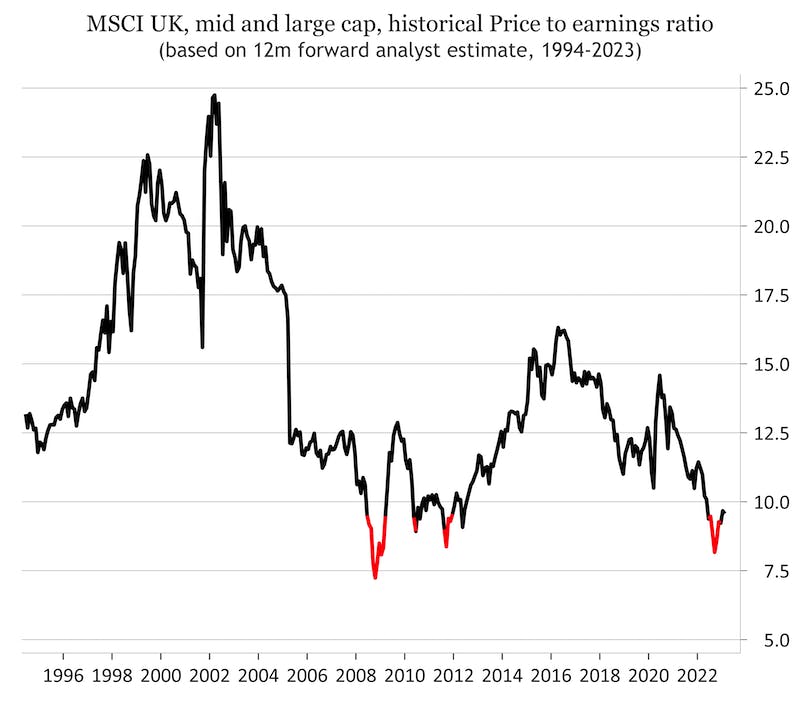
Look beyond the disquieting headlines around the health of the UK economy, and some of our largest multinational companies are thriving.
Despite being a difficult time for the domestic economy, UK large caps have been one of the few bright spots, outperforming other developed markets by a significant margin in 2022.
Keeping things simple, the universe we’ll cover here is the FTSE 100. This index encompasses giants like Shell and AstraZeneca, each with a market cap above £150bn, to the ‘smallest’ companies in the index, such as Frasers Group and Ocado, both around £4bn in size.
What is the impact of currency on UK large caps?
The scale of these behemoths means that a large proportion of their business is carried out internationally – at last count in 2022, an estimated 82% of earnings from FTSE 100 companies was derived overseas.
Many FTSE 100 companies report their earnings in US dollars. The dollar – seen as a ‘safe haven’ for many in times of economic uncertainty – was especially strong against other currencies last year and reached a 40-year high against the pound. This has been a tailwind for UK large-cap businesses; any earnings and dividends reported in dollars are worth more when converted back to sterling.
This year, the trend has reversed somewhat as markets believe that the US Federal Reserve is unlikely to raise interest rates significantly higher, inflation appears to be slowing, and global financial conditions are stabilising.
Still, many blue-chip firms benefit from the characteristic that while the UK economy may be struggling, they tend to be less affected than more domestically oriented smaller companies that are housed within the FTSE 250 or AIM markets.
What’s been behind UK large-cap outperformance?
In 2022, the FTSE 100 returned just under 5%, and from the start of 2023 to early March 2023, it has climbed by 7%.
In assessing performance, it makes sense to drill down and look at the make-up of the FTSE 100, which is unlike other major global equity indices. For example, around 57% of the value of the US equivalent index – the Nasdaq 100 – is accounted for by technology companies, a sector that’s not well represented in the FTSE 100. On the other hand, the FTSE 100 has a healthy weighting to financials, energy, and basic materials, which are only very minor contributors to the Nasdaq.
The sizeable footprint of these sectors means the FTSE 100 is often considered ‘old economy’, but that does mean it makes for a great diversifier held alongside other indices. Shares in more ‘traditional’ businesses – especially those related to energy – rallied in 2022. This goes some way to explaining why FTSE 100 has outperformed over developed market indices.
Consider also, the huge profits reported by the likes of Shell and Centrica (owner of British Gas) which benefited largely from a volatile period for commodity related assets in the wake of Russia’s invasion of Ukraine.
The case for investing in UK large-cap stocks
We’ve already touched upon how UK large caps, through holding the FTSE 100, can potentially be a good diversifier. Historically, because of the aforementioned sectors that make up a big proportion of the index, UK equities have empirically been less volatile than other markets.
This is especially pertinent given the extreme daily swings that we’ve seen in European and emerging markets in recent months. Indeed, this characteristic makes UK large caps a popular choice for investors during volatile times, as we saw during 2022.
The composition of the FTSE 100 also makes it relatively well suited for a period of low economic growth that we are likely to experience worldwide throughout this year. For example, the consumer staples and healthcare sectors typically make for more ‘defensive’ stocks, which become attractive in a slowdown environment in offering some level of stability.
The energy and materials sectors, which could be impacted by a slower economic growth, can also offer some level of resilience in a context of high inflation and resilient commodity prices.
Investing in UK large caps for income
UK large caps have long been a hunting ground for investors seeking income through dividends. While many companies within the FTSE 100 cut or halted dividend payments during the height of the first Covid lockdown in 2020, most have now resumed payouts that might exceed expectations this year. However, it’s also worth noting that just 10 stocks accounted for more than half of the dividend payments of the whole index last year.
We’ve also seen what is known as share buyback programmes from the likes of BP, Aviva, and Shell, which is another form of shareholder remuneration. This activity sees companies buy back their own shares to reduce their capital; while the number of issued shares falls, the worth of those in circulation increases.
Are UK large caps still ‘cheap’?
Amid ongoing talk of a UK recession on 16th February, the FTSE 100 hit a fresh all-time high, closing at over 8,000 points. Still, many investors consider UK large caps to be attractively priced versus other markets, trading as it is at a discount to US and European markets.
On a price-to-earnings (p/e) basis – a ratio used to value a company or index measuring its current price relative to earnings per share – the index still looks good value. In general terms, the lower the p/e, the “cheaper” the market or stock is. The current 12-month forward p/e ratio of the FTSE 100 is around 10, compared to an average of 14.3. Europe is currently trading at 13.3, while the US 18 versus an average of 17.

Source: Macrobond, MSCI
It could be argued that UK equities are still suffering from a fall-out in favour that goes back to the Brexit referendum in 2016. While the ongoing health of the UK on a global stage is still up for debate, it seems that many of the multinationals listed here remain largely unscathed.
How Nutmeg is allocated to UK large caps
Nutmeg portfolios have a long-term bias toward UK stocks structurally compared to the size of the UK economy in cap-weighted indices.
While this bias was less favourable and slightly difficult to carry during 2020 and 2021, it has been a compelling contributor lately as UK equities outperformed other markets. We have remained marginally overweight in large-cap UK equities during the past year, and so have benefited from this environment.
In previous years, periods of supportive monetary policy and low inflation have favoured high growth stocks, such as the technology stocks that are preeminent in the US. However, today’s economic environment is very different with inflation and tighter monetary policy taking centre stage.
The diversification benefit of UK large-cap stocks has been undeniable in the current environment and we believe will continue to be supportive in the near term.
Risk warning
As with all investing, your capital is at risk. The value of your portfolio with Nutmeg can go down as well as up and you may get back less than you invest. Past performance is not a reliable indicator of future performance.
